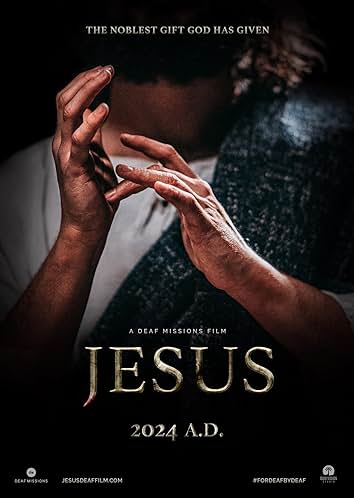More than 250 people stood in the hot sun outside the historical Texas Theatre in Dallas, Texas. They were all eagerly waiting to get inside to view a special showing of Jesus: A Deaf Missions Film. Anyone walking by this group would notice something different about how those people conversed with each other. The typical buzz of voices raising and falling was conspicuously absent. Instead, hands flew everywhere, and animated eyebrows rose and fell along with the sound of pure laughter.
This week, Jesus: A Deaf Missions Film is releasing in movie theaters all across the United States for the general public to view. The first-ever film created by the Deaf for the Deaf in American Sign Language (ASL) made widely available in theaters, this is a true cultural phenomenon. English subtitles are shown on screen for viewers who don’t know ASL or aren’t fluent in ASL.
The Effect of the Deaf Lens
My name is Marisa, and I work in DOOR’s communications. I was one of the few privileged to be able to view the special showing of Jesus in Texas, because my brother Tyler plays the disciple John in the film. Fun fact: acting isn’t his fulltime job! Tyler works for DOOR as the video editor for the translation resources team, and is heavily involved in the ASL Bible translation project done in partnership with Deaf Harbor. (He’s the guy immediately to the right of Jesus in the image below—the one with part of his face hidden).
Tyler and I come from an all-Deaf family, and I have five siblings other than Tyler. Yes, you counted that right—there are seven of us in all! Anyway, I am here today to tell you that, even though I myself am Deaf, I learned a lot about my own culture and community from this movie.
I walked out with a better understanding of Deaf culture after sitting through the two-and-a-half-hour film. Some things enthralled me, others stunned me, and I realized I had never seen anything like this. For anyone seeking to better understand the Deaf community, this movie provides a unique opportunity for you to see things through a Deaf lens like never before.
Deaf cultural values are prevalent in every frame of Jesus. I’m going to discuss three particular cultural values below and how Jesus incorporates them to make this a truly accessible film for the Deaf. My hope and prayer are that when you go see the film, you will remember a few things from this article and walk away with a deeper understanding and appreciation of Deaf culture. Let’s begin!

A Lack of Ambiguity
The main thing that struck me about this film is that it contains a very low level of ambiguity. This lines up well with Deaf culture because 90% of Deaf children are born to hearing parents (parents who aren’t Deaf). Sometimes those parents learn sign language, and sometimes they don’t. Many Deaf people have shared experiences where they are the sole Deaf person in a group setting—imagine a living room with the Deaf person sitting in the corner—and the conversations fly around them. They are maybe able to grasp a few things here and there, but full participation is difficult, often impossible. If everyone started laughing, they would ask one person, “What’s going on?” A common response is: “Oh, I’ll tell you later.” But that later never comes.
Imagine growing up without being immersed in the world of sound. Your eyes become your gateway to the world. Deaf culture places immense value on being clear and straightforward in their mode of communication. Euphemisms are rare and far between, because ambiguity is often a reminder of what was missed due to language barriers.
This movie shows this beautifully by presenting the subject matter through visual cues to get all the context you need. In movies not made for the Deaf, certain emotions are evoked through certain sounds. Or you can hear what’s happening off the screen, while your Deaf peers are left with subtitles that may or may not include those important cues. Jesus’ story is seen through the lens of the Deaf eye here, so there are scenes that may seem more up-close and personal than what is usual in the hearing world. Just sit back and take it all in. Consider what it would be like if you wanted things to be communicated as clearly as possible through a visual mode of communication.
Everyone's Voice Matters
Let’s return to that living room full of people with one Deaf person sitting in the corner. How many opportunities do you think that Deaf person would have to participate fully in the conversation? Now, granted, awareness of the Deaf community has grown in leaps and bounds over the past few years. And we are so grateful. However, there is still some work to do!
No one likes being left out. Unfortunately, Deaf people experience it more than most due to the language barrier. This leads us to our next Deaf cultural value: everyone’s voice matters.
If you visited one of DOOR’s Deaf-led churches, you would be surprised by how differently the church services are carried out compared to the traditional American church. After worship and a single person shares from God’s Word, everyone becomes engaged. Hands shoot up and everyone takes turns sharing what they had learned from the Bible or what God has done in their lives recently.
Most of those Deaf people may not have had many opportunities to contribute their opinions or insights throughout their childhoods. So, if you engage with a group of Deaf people, you may notice that they take more time to make sure everyone gets a chance to be heard. Everyone has a chance to express their thoughts.
You can see this in the movie by noticing how many group responses they have. If something happens, the camera will often show a group reacting to it by showing everyone in the room, and then panning in on each face to show their individual thoughts and feelings. This isn’t a common sight in movies not made for the Deaf. In Jesus, this happens over and over again. Everyone’s voice matters.
Face Time
Read the following sentence: “The man’s mad.” What tone did you assign to it as you read it? Did you read it in a worried, anxious tone? A shocked one? Upset? Amused?
Tone is a major component of spoken languages. Without tonal cues, you are left in the dark as you try to determine the emotions of the person speaking. You can pick up a few things from body language and facial expressions, but if the speaker isn’t visible, what do you do?
In sign languages, facial expressions equal tone. In Jesus, you will notice that there is a lot of “face time” for all of the actors. Often, they don’t even sign a single word. One lift of the eyebrow is enough to convey a world of meaning. Expressions are part of being human, and some cultures place a greater emphasis on them than others. Deaf cultures around the world deeply value facial expressions because, once again, our eyes are our gateway to the world. What we see informs what we understand. While watching this film, you will notice the depth and range of facial expressions on the actors’ faces. Maybe you could even learn a few things from them!
Go See the Movie!
My final word to you is: not every Deaf person experienced being left out or lacked access to language, but this is the experience of the majority of the Deaf community. Jesus: A Deaf Missions Film has taken Jesus’ life and death and put it into an entirely new lens in a way that brings Jesus close to the marginalized. It has made Jesus relatable to a new people group, and many Deaf people I talked to after seeing the movie felt like they now can really understand who He is and how much He loves them.
A friend of mine shared with me that her middle-aged Deaf father had fallen asleep during every single movie he had seen for the past five years or so. It didn’t matter what genre the movie was or how loud the sound was. He would doze off midway and wake up having missed a good portion. But as he sat in that historical theatre, he didn’t come close to dropping off a single time. His eyes were glued to the screen, and tears streamed down his face as he, for the first time, saw Jesus communicating in his heart language.
I saw such joy on so many faces after the movie was shown. Some of those people I’ve known for years, while others I had only just met that day. I know their stories, and I know the deep hurt they had received from the church by being left out. God is using this movie to come close to the Deaf community in a new way, and to heal the hurts they have experienced from the world. Pray with us that this movie would bring many to Christ.

Start the Conversation
This movie is a great example of why DOOR is so passionate about Deaf ministry. I would encourage you to go view the movie, ready to see what the world looks like through a Deaf lens and knowing that this will be an experience like no other. If you have questions about anything you viewed, or how what you saw relates to Deaf culture, reach out to a Deaf person. Give them an opportunity to have their voice be heard, and learn from them. I look forward to the conversations this will spark!



